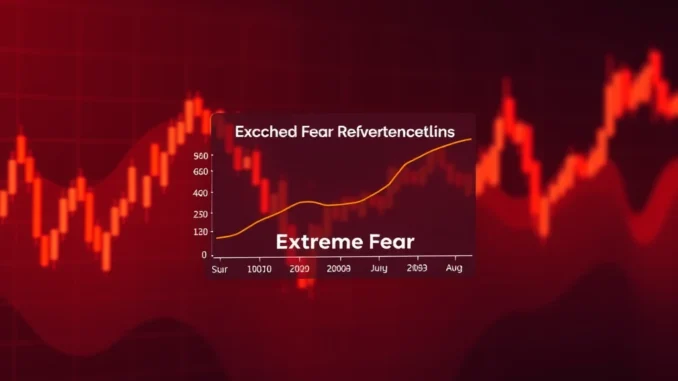
Feeling uneasy about the crypto markets lately? You’re not alone. The latest reading from the Crypto Fear & Greed Index is flashing red, indicating a significant shift in market sentiment towards ‘Extreme Fear’. Let’s dive into what this means for you and your crypto investments.
What is the Crypto Fear & Greed Index and Why Does It Matter?
Imagine a gauge that measures the emotional temperature of the cryptocurrency market. That’s essentially what the Crypto Fear & Greed Index is. Provided by Alternative.me, this index analyzes various market factors to determine whether investors are feeling fearful or greedy. It’s a useful tool to get a sense of the overall market mood and potential shifts in investor behavior.
Think of it this way:
- Extreme Fear (0-24): Often signals that investors are overly worried. This could be a sign that crypto assets are undervalued and potentially a buying opportunity.
- Fear (25-49): Indicates fear is present in the market, suggesting caution but also potential for price recovery.
- Neutral (50): Represents a balanced market sentiment, with neither strong fear nor greed dominating.
- Greed (51-74): Suggests increasing optimism and potential for market growth, but also a risk of overheating.
- Extreme Greed (75-100): Signals excessive optimism, which can be a warning sign of a market bubble and potential correction.
Currently, we’re in the ‘Extreme Fear’ zone. Let’s break down what led to this shift.
Why Has the Index Plunged into ‘Extreme Fear’?
As of March 10th, the Crypto Fear & Greed Index stands at a concerning 20. This is a significant seven-point drop from the previous day and a clear move from the ‘Fear’ zone deeper into ‘Extreme Fear’. This rapid descent indicates a notable weakening of market sentiment. Several factors contribute to this index reading, giving us a holistic view of market emotions.
The index isn’t based on just one metric; it’s a composite of several key market indicators. Here’s a breakdown of what fuels the Fear & Greed Index:
| Factor | Weight | Description |
|---|---|---|
| Volatility | 25% | Measures the current and maximum drawdowns of Bitcoin, comparing it with the average values of the last 30 and 90 days. Increased volatility often signals fear. |
| Market Momentum/Volume | 25% | Analyzes Bitcoin’s market momentum and trading volume compared to recent averages. High buying volume indicates greed, while low volume can suggest fear. |
| Social Media | 15% | Tracks sentiment on social media platforms, particularly Twitter, for relevant crypto hashtags. High positive interaction points towards greed. |
| Surveys | 15% | Conducts weekly crypto polls to gauge investor sentiment. This factor directly measures fear and greed through survey responses. |
| Bitcoin Dominance | 10% | Monitors Bitcoin’s dominance compared to other cryptocurrencies. Increased Bitcoin dominance can sometimes indicate a flight to safety during fearful times. |
| Google Trends | 10% | Analyzes Google Trends data for Bitcoin-related search queries. Increased searches for terms like “Bitcoin price crash” can indicate fear. |
What Does ‘Extreme Fear’ Mean for Your Crypto Portfolio?
Entering the ‘Extreme Fear’ zone can be unsettling, but it’s crucial to understand what it signifies and how to navigate it. Historically, periods of extreme fear in the crypto market have often presented unique opportunities. When the index is this low, it suggests that many investors are selling off their crypto holdings, potentially driving prices down to undervalued levels.
Here’s what you should consider:
- Potential Buying Opportunity? Contrarian investors often see ‘Extreme Fear’ as a signal to buy. The logic is that when fear is rampant, prices may be temporarily depressed, offering a chance to acquire assets at a discount.
- Market Volatility Likely to Continue: ‘Extreme Fear’ often correlates with high market volatility. Expect price swings and be prepared for potential dips. Risk management becomes paramount during these times.
- Bitcoin Dominance in Focus: Keep an eye on Bitcoin dominance. If it rises during ‘Extreme Fear’, it might suggest investors are moving away from riskier altcoins and towards the perceived safety of Bitcoin.
- Sentiment Can Shift Rapidly: The crypto market is known for its rapid shifts in market sentiment. ‘Extreme Fear’ can quickly turn into greed, especially with positive news or market developments. Stay informed and be ready to adapt your strategy.
Navigating Crypto Volatility and Extreme Fear: Actionable Insights
So, the Crypto Fear & Greed Index is flashing ‘Extreme Fear’ – what should you do? Here are some actionable insights to consider:
- Review Your Portfolio: Assess your current crypto holdings and their risk levels. Are you comfortable with the current level of crypto volatility? Consider rebalancing if necessary to align with your risk tolerance.
- Do Your Own Research (DYOR): Don’t make impulsive decisions based solely on fear. Conduct thorough research on projects you’re invested in or considering investing in. Understand their fundamentals and long-term potential.
- Dollar-Cost Averaging (DCA): If you believe in the long-term potential of crypto, consider using Dollar-Cost Averaging. Invest a fixed amount at regular intervals, regardless of the price. This can help mitigate the impact of crypto volatility and ‘Extreme Fear’ periods.
- Stay Informed: Keep up-to-date with market news, analysis, and the Crypto Fear & Greed Index. Understanding the factors driving market sentiment can help you make more informed decisions.
- Manage Your Emotions: ‘Extreme Fear’ is designed to evoke an emotional response. Avoid panic selling or making rash decisions driven by fear. Stick to your investment strategy and long-term goals.
The Bottom Line: Understanding Fear as a Market Indicator
The Crypto Fear & Greed Index dropping to 20 and entering ‘Extreme Fear’ is undoubtedly a noteworthy event. It signals a period of heightened anxiety and potential market turbulence. However, it’s crucial to remember that fear can also present opportunities. By understanding the factors driving the index, staying informed, and managing your emotions, you can navigate these volatile times and potentially position yourself for long-term success in the cryptocurrency market. Keep a close eye on how market sentiment evolves and be prepared to adapt your strategy as needed.



